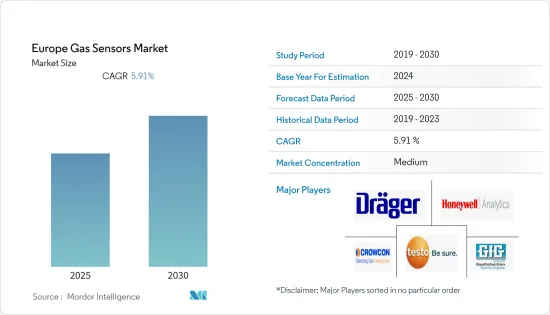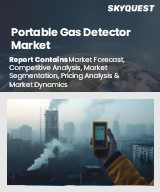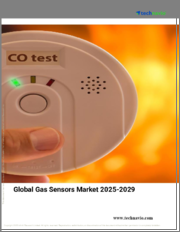
|
시장보고서
상품코드
1626343
유럽의 가스 센서 : 시장 점유율 분석, 산업 동향, 통계 및 성장 예측(2025-2030년)Europe Gas Sensors - Market Share Analysis, Industry Trends & Statistics, Growth Forecasts (2025 - 2030) |
||||||
■ 보고서에 따라 최신 정보로 업데이트하여 보내드립니다. 배송일정은 문의해 주시기 바랍니다.
유럽 가스 센서 시장은 예측 기간 동안 CAGR 5.91%를 나타낼 것으로 예상됩니다.

주요 하이라이트
- 유럽의 가스 센서 시장은 앞으로도 자동차 및 운송 용도이 주도할 것으로 예상됩니다. 오염 가스는 환기 시스템을 통해 차량 실내로 유입됩니다. 신선한 공기의 유입이 부족하여 산소(02) 농도가 낮아지거나, 창문을 통해 오염물질이 유입되거나, 배기가스 방향이 잘못되어 유해가스가 유입될 수 있습니다. 유럽에서는 엄격한 환경 및 안전 요구 사항으로 인해 모든 자동차 및 운송 장비 OEM이 제품에 가스 센서 기술을 포함하도록 의무화하고 있습니다.
- 또한, 이 지역에서는 IIoT도 발전하고 있습니다. 고객들은 IoT 가스 감지기에 대한 관심이 높아지고 있으며, 업계 기업들은 IoT 솔루션에 맞는 제품군을 구축하기 위해 노력하고 있습니다. 지속적인 실시간 모니터링 및 배출 감지 요구로 인한 무선 감지기의 필요성은 최근 몇 년동안 가스 감지기에 대한 수요를 증가시킬 것으로 예상됩니다.
- 이산화탄소 센서는 주로 가정, 학교, 사무실, 병원 등에서 실내 공기질을 모니터링하는 데 사용됩니다. 마찬가지로 이러한 센서는 농산물의 신선도, 품질 및 안전성을 실시간으로 모니터링하는 데에도 활용되고 있습니다. 따라서 이산화탄소에 과도하게 노출되면 두통이나 불안과 같은 건강 문제를 유발할 수 있기 때문에 이 지역에서 이산화탄소 센서에 대한 수요가 빠르게 증가하고 있습니다.
- 그러나 이 지역은 대규모 코로나19 사태를 겪고 있으며, 스페인, 프랑스, 이탈리아, 영국은 각국 정부가 폐쇄 명령을 내리고 있습니다. 그 결과 가스 센서 시장에 크게 의존하는 특정 최종 사용자 기업의 운영이 중단되어 시장이 어려움을 겪을 것으로 예상됩니다.
유럽의 가스 센서 시장 동향
유럽의 가스 센서 시장 동향가스센서 채택에 대한 정부의 지원적 규제
- 정부의 공해 규제가 강화됨에 따라 자동차 분야에서 가스 센서의 인기가 높아지고 있습니다. 예를 들어, 작년(2020년) 12월부터 개정된 일반 안전 규정은 자동차 제조업체가 속도 보조, 센서, 첨단 비상 제동 시스템, 데이터 기록 등 신기술을 고려하여 모든 차량에 보행자 안전 프로토콜을 의무적으로 적용하도록 요구하고 있습니다.
- 환기 시스템을 통한 오염 가스 유입, 창문을 통한 오염 물질 유입, 신선한 공기 유입 부족으로 인한 산소(02) 농도 감소, 배기가스 방향 전환으로 인한 독성 가스 유입 등은 모두 차량 실내 공기질에 큰 영향을 미칩니다. 그 결과, 엄격한 환경 및 안전 법규에 따라 모든 자동차 및 운송 기관 OEM은 가스 센서 시스템을 제공해야 합니다.
- 또한, 복잡한 안전기능과 첨단운전자보조시스템(ADAS)의 등장으로 안전성과 편의성이 고급차에서 중급차로 옮겨가면서 자동차 1대당 가스센서 및 감지기 부품의 사용량도 증가하고 있습니다.
- Bosch, Denso, Infineon Technologies와 같은 주요 자동차 센서 기업들은 다양한 용도를 위해 보다 기술적으로 정교하고 안전하며 보안이 강화된 가스 센서 기반 제품에 자금을 투자하고 있습니다.
가스 센서는 중요한 분야에서 높은 수요를 보임
- 가스 센서는 화학, 광업, 석유 및 가스, 전력과 같은 중요한 분야에서 가연성 및 독성 가스의 존재를 감지하고 모니터링하는 데 사용됩니다. 이러한 중요한 사업에서는 이산화탄소, 일산화탄소, 암모니아, 탄화수소, 황화수소 등 다양한 가스가 대기 중으로 배출됩니다. 이러한 가스가 대기 중으로 과도하게 배출되면 인체 건강에 악영향을 미칠 수 있습니다.
- 또한 프로판, 메탄, 부탄과 같은 일부 폭발성 가스는 이러한 중요한 사업에서 배출되어 화재를 유발할 수 있습니다. 위험한 가스로부터 생태계를 보호하기 위해 많은 규제 기관이 다양한 규제를 시행하고 있습니다.
- 따라서 이러한 가스를 감지 및 모니터링하고 이러한 가스가 대기 중으로 직접 방출되는 양이 적도록 개선 조치를 취해야 합니다. 따라서 중요 산업에서 센서와 같은 IoT 장치에 대한 수요 증가는 이 지역 시장을 크게 견인하고 있습니다.
유럽의 가스 센서 산업 개요
유럽의 가스 센서 시장은 부분적으로 단편화되어 있습니다. 이 시장의 주요 기업으로는 GFG Europe, Crowcon Detection Instruments Limited, Test SE &Co. 이 분야의 최근 동향은 다음과 같습니다.
- 2021년 10월, 하니웰은 비, 안개, 눈 및 기타 악천후에도 유해 가스를 지속적으로 모니터링하여 화학, 석유 및 화학, 석유 및 가스 및 기타 산업 직원과 현장의 안전을 보장할 수 있는 새로운 블루투스(R)* 연결 가스 감지기 2종을 출시한다고 발표했습니다.
- 2021년 1월, 존슨콘트롤즈의 신제품 GS3000은 일산화탄소(CO) 또는 이산화질소(NO2) 수치를 모니터링하고 실외 및 실내 용도 모두에서 과도한 농도를 조기에 경고합니다.
기타 혜택 :
기타 혜택- 엑셀 형식 시장 예측(ME) 시트
- 3개월간의 애널리스트 지원
목차
제1장 서론
- 조사의 전제조건과 시장 정의
- 조사 범위
제2장 조사 방법
제3장 주요 요약
제4장 시장 인사이트
- 시장 개요
- 밸류체인/공급망 분석
- 업계의 매력 - Porter의 Five Forces 분석
- 신규 진출업체의 위협
- 바이어의 교섭력
- 공급 기업의 교섭력
- 대체품의 위협
- 경쟁 기업간 경쟁 관계
- COVID-19의 업계에 대한 영향 평가
제5장 시장 역학
- 시장 성장 촉진요인
- 공기 품질 모니터와 HVAC 시스템에의 가스센서 통합 증가
- 지지적인 정부 규제
- 시장 성장 억제요인
- 비용과 기술적 우려 증대
제6장 시장 세분화
- 가스 유형별
- 산소
- 이산화탄소
- 일산화탄소
- 질소산화물
- 탄화수소
- 기타
- 접속 유형별
- 유선
- 무선
- 기술별
- 전기화학
- 상자성
- 지르코니아
- 비파괴 IR
- 용도별
- 석유 및 가스
- 화학제품 및 석유화학제품
- 상하수도
- 자동차
- 헬스케어
- 전력
- 기타
- 국가별
- 영국
- 독일
- 프랑스
- 기타 유럽
제7장 경쟁 구도
- 기업 개요
- Honeywell Analytics Inc.
- Johnson Controls Corporation
- Testo SE & Co. KGaA
- Comtrol Instruments Corporation
- RAE Systems
- ABB Ltd.
- GFG Europe
- Draegerwerk AG & Co. KGaA
- MSA Safety Incorporated
- Teledyne Technologies Incorporated(3 M)
제8장 투자 분석
제92장 시장의 미래
LSH 25.01.15The Europe Gas Sensors Market is expected to register a CAGR of 5.91% during the forecast period.

Key Highlights
- The European gas sensor market is projected to continue to be dominated by automotive and transportation applications. Pollutant gases enter the car cabin through the ventilation systems. There is a shortage of fresh air intake, which results in low oxygen (02) concentrations, pollutants entering through window apertures, and hazardous gases entering via misdirected exhaust fumes. In Europe, strict environmental and safety requirements require all vehicle and transportation OEMs to include gas sensor technologies in their offers.
- Additionally, the IIoT is also advancing in the region. Customers are becoming more interested in IoT gas detectors, and players in the industry are working on establishing a product range tailored to IoT solutions. The necessity for wireless detectors owing to the requirement of continuous and real-time monitoring and detection of emissions is predicted to drive up demand for gas detectors in recent years and the coming years.
- Carbon dioxide sensors are primarily used in households, schools, offices, and hospitals to monitor indoor air quality. Similarly, these sensors are also utilized for real-time monitoring of agricultural goods' freshness, quality, and safety. Therefore, as excessive carbon dioxide exposure can cause health problems such as headaches and restlessness, the need for carbon dioxide sensors is rapidly increasing in this region.
- However, the region is experiencing a sizeable COVID-19 epidemic, with lockdowns ordered by the individual governments in Spain, France, Italy, and the United Kingdom. As a result, the market is projected to suffer due to disruptions in the operations of particular end-user businesses that rely heavily on the gas sensors market.
Europe Gas Sensors Market Trends
Supportive Government Regulations for Adopting Gas Sensors
- The popularity of gas sensors in the automobile sector is increasing as government pollution rules become more rigorous. For example, starting in December of last year (2020), the revised General Safety Regulation will require automakers to make pedestrian safety protocols mandatory for all vehicles, taking into account new technologies like speed assistance, sensors, advanced emergency braking systems, data recording, and so on.
- The entrance of pollutant gases through ventilation systems, pollutants entering through window apertures, a lack of fresh air intake resulting in low oxygen (02) concentrations, and toxic gases entering via redirected exhaust fumes all have a significant impact on the air quality in the car cabin. As a result, strict environmental and safety laws oblige all vehicle and transportation OEMs to offer gas sensor systems.
- Additionally, the usage of gas sensor and detector components per car is being enhanced by the migration of safety and comfort features from high-end sector vehicles to mid-range vehicles, owing to the rise of complex safety features and advanced driver assistance systems (ADAS).
- Leading automotive sensor companies like Bosch, Denso, and Infineon Technologies are putting their money into more technologically sophisticated, safer, and secure gas sensor-based products for a variety of applications.
Gas sensors are in high demand in Critical Sectors
- Gas sensors are used in critical sectors, including chemical, mining, oil and gas, and electricity, to detect and monitor the presence of flammable and poisonous gases. These vital businesses emit a huge variety of gases into the atmosphere, including carbon dioxide, carbon monoxide, ammonia, hydrocarbons, and hydrogen sulfide. Excessive emissions of these gases into the atmosphere can have a negative impact on human health.
- Furthermore, some explosive gases, such as propane, methane, and butane, may be discharged by these important businesses, potentially resulting in fires. Various restrictions are being implemented by many regulatory agencies to protect the ecology from dangerous gases.
- This necessitates the detection and monitoring of these gases, as well as the implementation of remedial actions to ensure that only a small amount of these gases is released directly into the atmosphere. Therefore, the increasing demand for IoT devices such as sensors in critical industries is significantly driving the market in this region.
Europe Gas Sensors Industry Overview
Europe Gas Sensors Market is partially fragmented. Some of the major players in the market are GFG Europe, Crowcon Detection Instruments Limited, Testo SE & Co. KGaA, Honeywell Analytics Inc., Draegerwerk AG & Co. KGaA, and others. Recent Developments made in this sector are:
- In October 2021, Honeywell has announced the availability of two new Bluetooth(R)*-connected gas detectors that can provide continuous monitoring for harmful gases even in the rain, fog, snow, and other adverse weather, ensuring the safety of chemical, petrochemical, oil, and gas, and other industrial employees and sites.
- In January 2021, the GS3000, a new product from Johnson Controls Corporation, monitors levels of carbon monoxide (CO) or nitrogen dioxide (NO2) to provide early alerts of excessive concentrations in both outdoor and indoor applications.
Additional Benefits:
- The market estimate (ME) sheet in Excel format
- 3 months of analyst support
TABLE OF CONTENTS
1 INTRODUCTION
- 1.1 Study Assumptions and Market Definition
- 1.2 Scope of the Study
2 RESEARCH METHODOLOGY
3 EXECUTIVE SUMMARY
4 MARKET INSIGHTS
- 4.1 Market Overview
- 4.2 Value Chain / Supply Chain Analysis
- 4.3 Industry Attractiveness - Porter's Five Force Analysis
- 4.3.1 Threat of New Entrants
- 4.3.2 Bargaining Power of Buyers
- 4.3.3 Bargaining Power of Suppliers
- 4.3.4 Threat of Substitute Products
- 4.3.5 Intensity of Competitive Rivalry
- 4.4 Assessment of COVID-19 impact on the Industry
5 MARKET DYNAMICS
- 5.1 Market Drivers
- 5.1.1 Increasing Integration of gas sensors into air quality monitors and HVAC systems
- 5.1.2 Supportive Government Regulations
- 5.2 Market Restraints
- 5.2.1 Increasing Cost and Technical Concerns
6 MARKET SEGMENTATION
- 6.1 By Gas Type
- 6.1.1 Oxygen
- 6.1.2 Carbon Dioxide
- 6.1.3 Carbon Monoxide
- 6.1.4 Nitrogen Oxide
- 6.1.5 Hydrocarbon
- 6.1.6 Others
- 6.2 By Connectivity Type
- 6.2.1 Wired
- 6.2.2 Wireless
- 6.3 By Technology
- 6.3.1 Electrochemical
- 6.3.2 Paramagnetic
- 6.3.3 Zirconia
- 6.3.4 Non-disruptive IR
- 6.4 By Application
- 6.4.1 Oil and Gas
- 6.4.2 Chemicals and Petrochemicals
- 6.4.3 Water and Wastewater
- 6.4.4 Automotive
- 6.4.5 Healthcare
- 6.4.6 Power Sector
- 6.4.7 Others
- 6.5 By Country
- 6.5.1 United Kingdom
- 6.5.2 Germany
- 6.5.3 France
- 6.5.4 Rest of Europe
7 COMPETITIVE LANDSCAPE
- 7.1 Company Profiles
- 7.1.1 Honeywell Analytics Inc.
- 7.1.2 Johnson Controls Corporation
- 7.1.3 Testo SE & Co. KGaA
- 7.1.4 Comtrol Instruments Corporation
- 7.1.5 RAE Systems
- 7.1.6 ABB Ltd.
- 7.1.7 GFG Europe
- 7.1.8 Draegerwerk AG & Co. KGaA
- 7.1.9 MSA Safety Incorporated
- 7.1.10 Teledyne Technologies Incorporated (3M)
8 INVESTMENT ANALYSIS
9 FUTURE OF THE MARKET
샘플 요청 목록



















